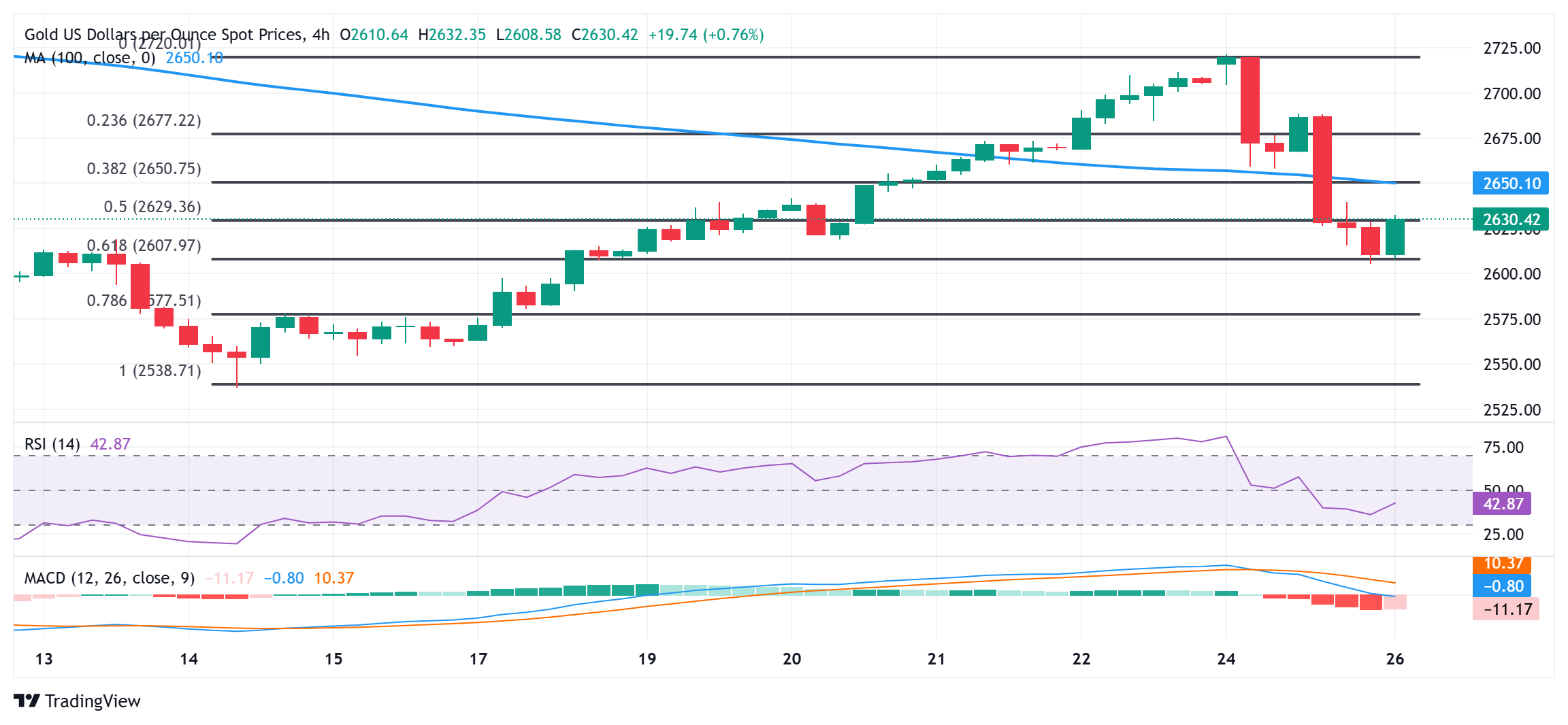Gold Price Stalls Intraday Recovery From $2,600 Amid Rising US Bond Yields

Image Source: Pixabay
- Gold price attracts some haven flows near $2,600 after Trump’s tariff threats.
- Rebounding US bond yields underpin the USD and cap gains in XAU/USD.
- Traders now look to FOMC meeting minutes for some meaningful impetuses.
Gold price (XAU/USD) struggles to capitalize on its modest intraday bounce from the $2,600 neighborhood, or over a one-week low, and retains a negative bias for the second straight day on Tuesday. US President-elect Donald Trump's tariff threat drove some haven flows and offered some support to the safe-haven precious metal. The attempted recovery, however, lacks follow-through buying amid expectations for a less dovish Federal Reserve (Fed).
Investors seem convinced that Trump's expansionary policies will reignite inflation and force the Fed to cut interest rates slowly. This, in turn, triggers a fresh leg up in the US Treasury bond yields, which is seen acting as a tailwind for the US Dollar (USD) and undermining demand for the non-yielding Gold price. Apart from this, optimism over Scott Bessent's nomination as the US Treasury Secretary and a possible Israel-Hezbollah ceasefire cap the XAU/USD.
Gold price bulls refrain from placing aggressive bets amid expectations for slower Fed rate cuts
- The optimism over Scott Bessent's nomination as the US Treasury secretary and the Israel-Hezbollah ceasefire deal weighed heavily on the safe-haven Gold price at the start of a new week.
- Hopes that Bessent will take a more phased approach on tariffs in an attempt to rein in the budget deficit triggered a sharp fall in the US Treasury bond yields and undermined the US Dollar.
- The yield on the benchmark 10-year US government bond dropped by the most since early August, though the downfall remains limited amid bets for a less dovish Federal Reserve.
- Chicago Fed President Austan Goolsbee said on Monday that barring some convincing evidence of overheating, he foresees the central bank continuing to lower rates.
- Separately, Minneapolis Fed President Neel Kashkari said that it is still appropriate to consider another interest-rate reduction at the December FOMC policy meeting.
- Traders, however, continue scaling back their bets for another 25-basis-points Fed rate cut in December amid expectations that Trump's policies will boost inflation.
- This acts as a tailwind for the US bond yields and assists the USD to fill the weekly bearish gap, which might cap any meaningful upside on the non-yielding yellow metal.
- US President-elect Donald Trump threatened to impose a 25% tariff on all products coming into the US from Mexico and Canada and an additional 10% tariff on all Chinese imports.
- Meanwhile, Israeli forces have intensified operations in north Gaza in recent weeks and continue to hammer Lebanon, raising the risk of a further escalation of conflict.
- Adding to this, worries about the economic impact of increased duties temper investors' appetite for riskier assets and drive some haven flows towards the XAU/USD.
- Market players now look to the FOMC minutes for cues about the future rate-cut path, which will drive the USD demand and provide a fresh impetus to the commodity.
- This week's US economic docket also features the first revision of the US Q3 GDP print and the release of the US Personal Consumption and Expenditure (PCE) Price Index.
Gold price could resume its corrective from the all-time peak once $2,600 is broken decisively
From a technical perspective, the intraday bounce from the 61.8% Fibonacci retracement level of the recent recovery from a two-month low is likely to face stiff resistance near the $2,650 confluence. The said area comprises the 100-period Simple Moving Average (SMA) on the 4-hour chart and the 38.2% Fibo. level, which, in turn, should act as a key pivotal point. A sustained strength beyond could trigger a short-covering rally towards the $2,700 mark en route to the overnight swing high, around the $2,721-2,722 zone.
On the flip side, the $2,600 round figure (61.8% Fibo. level) might continue to protect the immediate downside. Some follow-through selling will expose the 100-day SMA, currently pegged near the $2,565 region. The subsequent decline has the potential to drag the Gold price towards the monthly swing low, around the $2,537-2,536 area. A convincing break below the latter will be seen as a fresh trigger for bearish traders and set the stage for an extension of the recent sharp retracement slide from the $2,800 neighborhood, or the all-time peak touched in October.
More By This Author:
Japanese Yen Remains On The Front Foot Against USD; Upside Potential Seems LimitedUSD/CHF Price Prediction: Pulling Back Within An Uptrend
USD/CAD Refreshes Daily High On Sliding Oil Prices; Remains Below 1.4000 Amid Weaker USD
Information on these pages contains forward-looking statements that involve risks and uncertainties. Markets and instruments profiled on this page are for informational purposes only and should not ...
more



